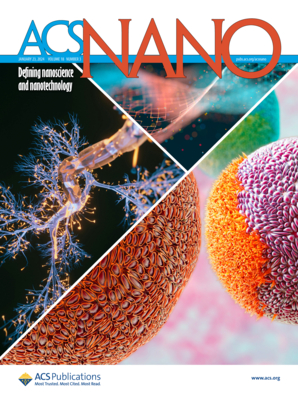Enhance Efferocytosis and Block the Macrophages–Platelets Feedback Loop for Targeted Treatment of Psoriasis
IF 16
1区 材料科学
Q1 CHEMISTRY, MULTIDISCIPLINARY
引用次数: 0
Abstract
Efferocytosis of macrophages infiltrated in psoriatic lesions is mostly impaired, thus promoting the progression of psoriasis. Herein, we reveal that there exists a feedback loop between activated platelets and efferocytosis-impaired macrophages in psoriatic. Or rather, efferocytosis-impaired macrophages stimulate platelet activation, which in turn down-regulates the expression of the phagocytic receptor Mer on macrophages and polarizes macrophages to the M1-phenotype of weaker efferocytosis ability. Therefore, we construct a combined nanoplatform for more precise targeting to efferocytosis-impaired macrophages and activated platelets. The macrophage-targeting part of the nanoplatform efficiently orientates to efferocytosis-impaired macrophages through macrophage membrane encapsulation and targeting peptide modification. This increases the expression of Mer, simultaneously enhances the acidification and maturation of efferosomes, ultimately restores efferocytosis of macrophages, and promotes the phagocytosis and clearance of apoptotic cells. On the other hand, the activated platelet-targeting nanoparticles inhibit the activation of platelets, thus blocking the feedback loop and eventually preventing the down-regulation of Mer expression on macrophages. Furthermore, the combined nanoplatform suppresses the infiltration of macrophages and platelets in psoriatic lesions, reduces the release of pro-inflammatory factors such as IL-17A, and consequently improves the therapeutic effect of psoriasis and prevention of its recurrence in vivo. Collectively, this two-pronged strategy with multifunctionality in repairing efferocytosis, inhibiting platelet activation, and blocking the feedback loop may provide options available for the treatment of psoriasis.

增强efferocysis和阻断巨噬细胞-血小板反馈回路靶向治疗银屑病
银屑病病变中浸润的巨噬细胞的胞浆功能大多受损,从而促进银屑病的进展。在此,我们揭示了银屑病中活化的血小板和efferocyking受损的巨噬细胞之间存在反馈回路。或者说,吞噬功能受损的巨噬细胞刺激血小板活化,从而下调吞噬受体Mer在巨噬细胞上的表达,使巨噬细胞极化至吞噬能力较弱的m1表型。因此,我们构建了一个联合的纳米平台,以更精确地靶向efferocyts受损的巨噬细胞和活化的血小板。纳米平台的巨噬细胞靶向部分通过巨噬细胞膜包封和靶向肽修饰,有效地定向到efferocyte受损的巨噬细胞。这增加了Mer的表达,同时增强了efferome的酸化和成熟,最终恢复巨噬细胞的efferocysis,促进凋亡细胞的吞噬和清除。另一方面,活化的靶向血小板纳米颗粒抑制血小板的活化,从而阻断反馈回路,最终阻止巨噬细胞上Mer表达的下调。此外,联合纳米平台可抑制银屑病病变中巨噬细胞和血小板的浸润,减少IL-17A等促炎因子的释放,从而提高银屑病的治疗效果,防止银屑病在体内复发。总的来说,这种双管齐下的策略在修复effocytosis,抑制血小板活化和阻断反馈回路方面具有多功能性,可能为银屑病的治疗提供了可用的选择。
本文章由计算机程序翻译,如有差异,请以英文原文为准。
求助全文
约1分钟内获得全文
求助全文
来源期刊

ACS Nano
工程技术-材料科学:综合
CiteScore
26.00
自引率
4.10%
发文量
1627
审稿时长
1.7 months
期刊介绍:
ACS Nano, published monthly, serves as an international forum for comprehensive articles on nanoscience and nanotechnology research at the intersections of chemistry, biology, materials science, physics, and engineering. The journal fosters communication among scientists in these communities, facilitating collaboration, new research opportunities, and advancements through discoveries. ACS Nano covers synthesis, assembly, characterization, theory, and simulation of nanostructures, nanobiotechnology, nanofabrication, methods and tools for nanoscience and nanotechnology, and self- and directed-assembly. Alongside original research articles, it offers thorough reviews, perspectives on cutting-edge research, and discussions envisioning the future of nanoscience and nanotechnology.
 求助内容:
求助内容: 应助结果提醒方式:
应助结果提醒方式:


